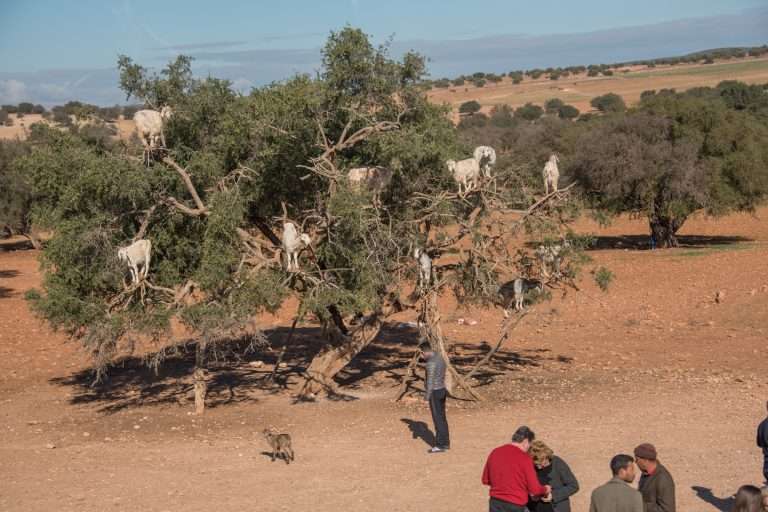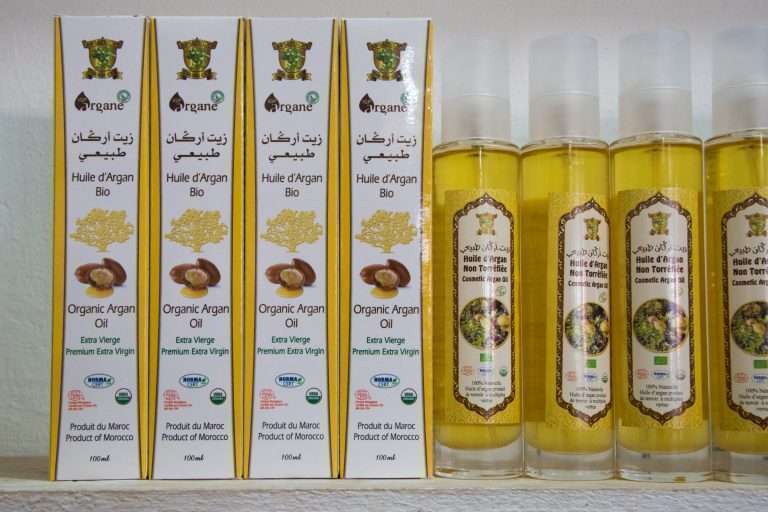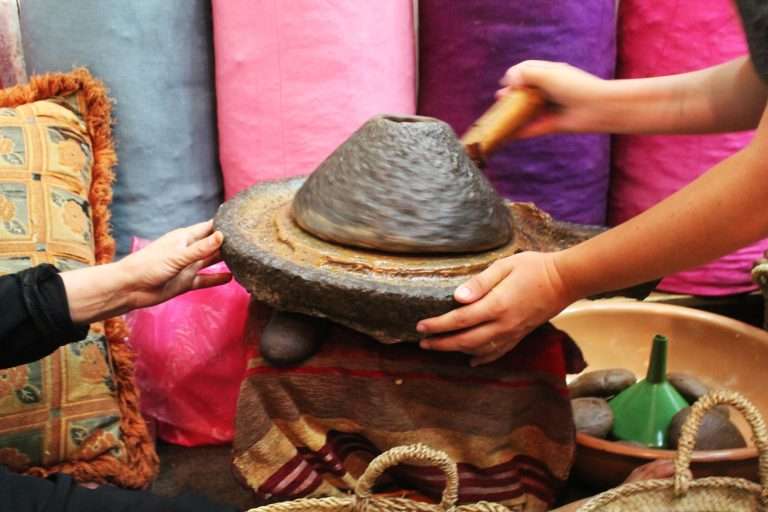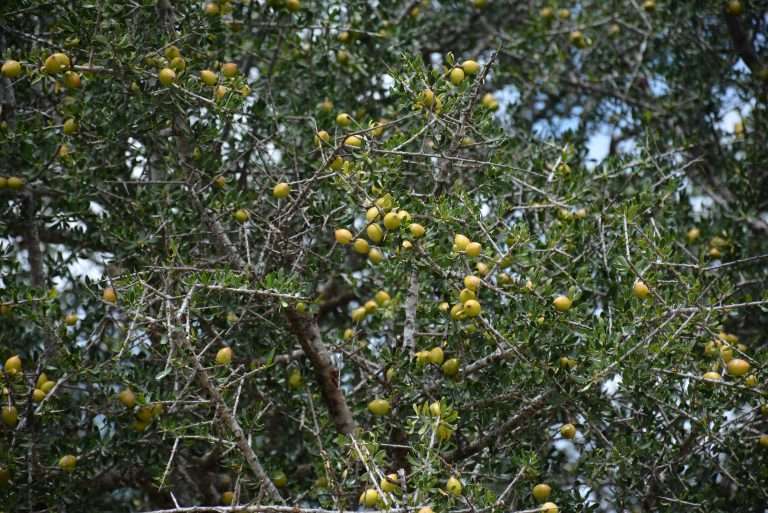Argan Oil Morocco, About Golden Liquid

Argan oil, a traditional Moroccan product, has gained popularity in the western world. Derived from the Argan tree, native to Morocco, this oil is known for its nourishing and moisturizing properties. It is rich in essential fatty acids, antioxidants, and vitamin E. Argan oil is used in culinary, cosmetic, and medicinal applications. Its production supports local communities, particularly women’s cooperatives. As the demand for Argan oil continues to rise, it is important to recognize its deep-rooted tradition in Morocco.
Argan Trees

There are two main overlooked facts about the argan tree in Morocco and its production: firstly, it thrives mainly in arid zones; and secondly, it bears fruit. The fruit of the argan tree is oval in shape, resembling olives but with a greenish-yellow color and a hard exterior layer. The pulp inside the fruit is bitter and unpleasant in taste, often used as animal food.
Within the fruit, we find two or three almond-like seeds. It is from these seeds that the well-known argan oil is extracted, requiring a minimum of 100 kilograms of fruit (including their water content) to produce a liter of oil. The labor involved in this process is quite significant!
Argan oil can be obtained through two different methods: the modern industrial approach and the traditional method, although there are some urban myths surrounding the traditional way of obtaining the “Moroccan gold.”
Industrial Process of Argan Oil Extraction

The Industrial Process of Argan Oil Extraction involves three phases: pulp removal, seed extraction, and oil grinding. Specialized machines are used for each phase, with operators assisting as needed. In the first phase, a machine cuts the surface of the pulp to separate it, or an operator does it manually. The second phase follows a similar approach. In the final phase, the seeds undergo roasting, milling, and oil extraction.
Traditional Argan Oil Extraction Process

The traditional process of obtaining argan oil can be categorized into two methods, distinguished by the first phase of separating the fruit pulp. In one approach, the fruits and their skin naturally dry up, falling from the tree and becoming easy to separate. Alternatively, the pulp is taken care of by individuals or goats who consume the pulp and later expel the fruit.
Considering that argan trees need to reach an average height of approximately three meters before the first leaves appear, you might question how goats are able to access these branches.

The apparent impossibility of goats climbing argan trees has a simple explanation. Since the argan tree predominantly grows in arid areas with minimal vegetation, the scarcity of food leaves our goat friends with no option but to climb the tree and consume its leaves and fruits.

The traditional process begins by crushing the pulp-free fruits with a stone to extract the seeds. These seeds are then roasted over a wood fire. Next, the roasted seeds are ground in a mill to create a paste. Water is added to the paste, which is then kneaded until the oil is obtained. This laborious process can take over six hours to produce just one liter of oil. Interestingly, it is predominantly women who practice this tradition, using the oil for both culinary and skincare purposes.

Argan oil production is primarily concentrated between Essaouira and Agadir, as well as in the Anti-Atlas region, where numerous cooperatives operate. Prices for argan oil can vary, with lower quality oils typically priced around 25 euros per liter, while better quality oils or those purchased directly from cooperatives can range around 40 euros per liter.
Busting Urban Myths about Argan Oil Extraction
There is a popular belief, even among Moroccans, that goats play a peculiar role in the process of argan oil extraction. According to the urban legend, goats consume the argan fruit along with its pulp, but only digest the pulp while excreting the intact fruit, resulting in an unpleasant smell in some argan oil.
However, this notion is far from accurate. Goats do not need to go through the extraordinary act of defecating undigested argan fruit. As ruminant animals, they consume the fruit and its pulp, and then regurgitate and chew on it during rumination. What remains undigested, including the argan fruit, is eventually expelled. This natural process ensures that goats efficiently extract nutrients from their food while discarding what they cannot digest.
It’s important to dispel this myth and understand that the extraction of argan oil involves more conventional methods rather than relying on goats for the separation of the fruit pulp
Argan Fruits

The Smell of Argan Oil
The unique smell of argan oil can be attributed to the natural odor emitted by the split argan seeds. To mitigate this, the seeds are traditionally roasted, giving the oil a pleasant hazelnut-like aroma. However, variations in smell can occur depending on the production method.
Homemade argan oils, primarily used for skincare, may retain a stronger natural scent as they are often cold-pressed. Conversely, in the industrial process, the seeds undergo both roasting and deodorization to achieve a milder and more neutral aroma. Deodorization is a common practice in the industrial production of argan oil, ensuring a consistent and appealing scent.
Understanding the reasons behind the different smells of argan oil in Morocco helps debunk any misconceptions and highlights the significance of roasting and deodorization in the overall production process.
Uses of Argan Oil
Argan oil is an extensively utilized product in Morocco, renowned for its diverse applications. It finds wide usage in cosmetic routines, as it is commonly applied to the skin. However, its benefits extend beyond just skincare; it is also employed in various other parts of the body and can even be consumed as a food item. Let’s delve into its primary uses:
Cosmetic use
Argan oil has been scientifically proven to possess remarkable properties that deeply moisturize, protect, and regenerate the skin, making it an effective anti-wrinkle agent. Its nourishing and moisturizing qualities also make it highly beneficial for hair care, providing lustrous shine and softness.
When applied to nails, combined with a few drops of lemon juice, it revitalizes and enhances their natural radiance. Additionally, argan oil is widely favored as a massage cream, making it a prominent feature in Hammams and massage centers throughout Morocco.
Food use
It is used frequently for this purpose, since it reduces cholesterol and prevents cardiovascular ailments. For example, it is common to join the ground almonds and eat with bread, having a flavor similar to nougat. Sometimes, it is mixed with an almond paste and honey, producing the Amloul, a delicious cream that is rarely found outside the areas where the argan is produced.
You may also be interested in: Top Moroccan Foods
Interested to buy argan oil and visit Morocco?
We are a renowned travel company located in the mesmerizing Sahara desert of Morocco, boasting a highly skilled team of experts who excel in crafting exceptional tours across the country. With over six years of experience in organizing unforgettable journeys to captivating destinations such as the desert, imperial cities, and other fascinating locales, we extend an invitation to embark on a trip of a lifetime.
Morocco is renowned for its wide availability of high-quality Argan oil, and we offer you the opportunity to not only purchase this remarkable product but also indulge in its culinary delights. Our knowledgeable team will be at your disposal, providing expert guidance and assistance in exploring the world of Argan oil. We will take you to places where you can immerse yourself in reading and gathering information about this precious oil.
During your tour, you will witness firsthand the pure and certified production of Argan oil, as the skilled hands of Berber women demonstrate the entire process. Many of our tours include visits to female cooperatives nestled in various regions, particularly the majestic High Atlas mountains near Marrakech. Here, you will marvel at the traditional and simplistic methods employed by these women in the production of oil and cosmetics. Witnessing the tools and techniques passed down through generations will surely leave you in awe.
It’s worth mentioning that the largest concentration of Argan trees can be found on the route from Marrakech to Essaouira, the enchanting city of wind. Moreover, numerous cooperatives in the area are family-owned by locals hailing from Essaouira.
Join us on this extraordinary journey, where you’ll not only explore the breathtaking landscapes of Morocco but also delve into the fascinating world of Argan oil, guided by our passionate team of experts.


0 Comment